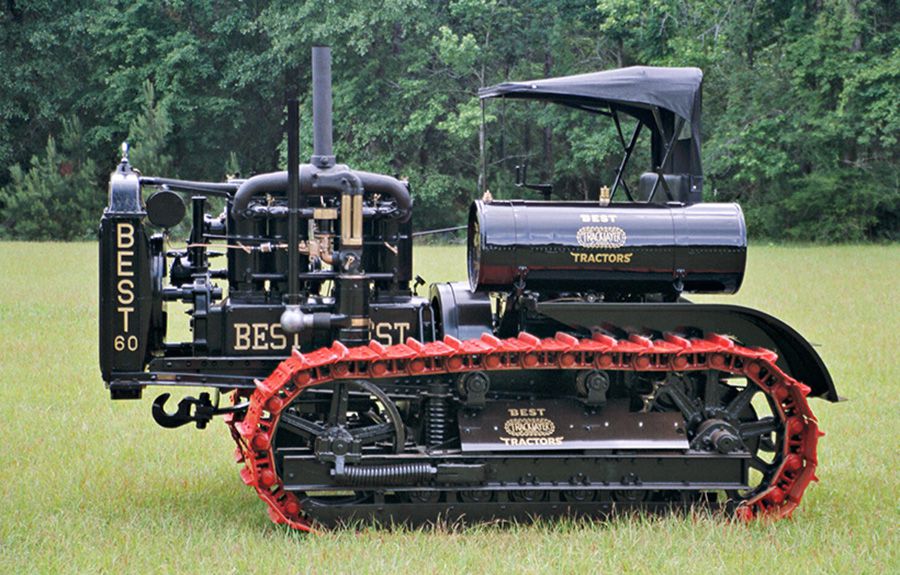Much has been made of Benjamin Holt’s contributions to the development of the crawler tractor. For good reason, as Holt pioneered a great many early advances that made his Caterpillars some of the most popular crawler tractors of their time.
Often overlooked, however, is the engineering and business genius of Clarence Leo Best and his Tracklayer tractors. Best is often given begrudging acknowledgement by some historians as being little more than a fierce rival of Holt’s prior to the creation of Caterpillar Tractor Company in 1925. Bear in mind, however, that Caterpillar Tractor was created by an equal merger of the Best and Holt interests.
Best Museum
A Holt Employee
The relationship between Benjamin Holt and Clarence Best started out as boss and employee after Holt purchased Best’s father’s crawler company in 1908. Within two years, however, Best left his position as manager of Holt’s San Leandro, California, plant to go head-to-head against Holt with the creation of the C.L. Best Gas Traction Company.
At first, Best turned out wheeled tractors powered by Buffalo engines ranging from 40 to 90 hp. In 1912, he introduced a rear-tracked tractor steered by a front (tiller) wheel. Already, Best’s penchant for innovation was showing.
His 70 hp. Tracklayer had many advances not found in other crawler tractors such as power-assisted steering for the tiller wheel. Soon massive 90 and 120 hp. Tracklayers were added to the Best line.
Best’s Apprenticeship With His Father
As a young man, Clarence Best’s knowledge of tractors was thorough due to the fact that he was brought up in the business by his father, Daniel Best. Acclamation to crawlers came early to Clarence and likely at the dinner table when his father talked of his day developing tractors that ran on steam and then gas.
Little wonder that Clarence came to work for his father right out of high school and was present when Daniel Best filed a lawsuit against Benjamin Holt for patent infringement — a case that really only got settled when Best sold his company to Holt in 1908.
The fierce rivalry that existed between Best and Holt rubbed off on Clarence early in his life. So it was little wonder when Clarence left the Holt operation in 1910 and set out to challenge Holt with a line of crawlers of his own design.
Finally, the fact that Clarence was such an accomplished engineer can also be traced back to his father. Daniel Best innovated one of the earliest steam traction engines in 1887 a year before Holt’s first steamer. Daniel Best went on to introduce an internal combustion-powered tractor in 1896.
Best Museum
The Venerable Model 60
By 1919, sales of Tracklayers were brisk. Best responded to his success first by expanding manufacturing production and then by introducing a full- tracked tractor that is now considered one
of the greatest crawler models ever built, the model 60 Tracklayer.
The Best 60 quickly established itself as the standard by which all other crawlers would be measured, offering numerous engineering firsts, including:
- Oscillating track sections that, besides greatly smoothing the crawler’s ride, kept the tracks in solid contact with the ground, providing increased traction in rough conditions.
- Extensive use of antifriction bearings, particularly in the track assembly, to reduce friction and wear in crucial mechanical areas.
- A two-speed transmission that was later increased to three gear sets to allow the operator to match crawler speed to the workload.
- A steering system employing roller bearing-mounted, multiple-disk enclosed friction clutches.
This approach to steering, in particular, set the 60 apart from its competition at the time. The design applied power to both tracks even when the 17,500-pound crawler was being turned. A huge differential enabled the crawler tractor to pull just as hard around a corner as on the straightaway.
Topping off the 60 — and one of the crawler’s best assets — was a workhorse of an engine designed and built by Best Tractor. This four-cylinder, valve-in-head power plant (6 1⁄2 × 8 1⁄2 bore and stroke) turned out 56 hp. when first evaluated at the Nebraska Tractor Test.
That output reached the manufacturer’s rating of 60 hp. at the belt (30 hp. at the drawbar) when the Tracklayer was retested three years later. Testifying to the engine’s ability to pump out reserve power, the Tracklayer delivered a whopping 72 1⁄2 brake hp. under maximum load evaluation.
Dave Mowitz, Best Museum
Again, Best employed antifriction bearings throughout his engines, making the units particularly rugged and long-lived.
With all these attributes, the Tracklayer 60 fast gained a reputation as a premium crawler sold at a competitive price of $5,750 (in 1922).
Not long after the 60’s introduction in 1921, Best brought out a little brother, the Tracklayer 30 — rated at 30-belt hp.
Like the model 60, the Tracklayer 30 was tough, hardworking, and popular.
Market Turndown
Unfortunately, both Best and Holt faced considerable difficulties in the 1920s when tractor sales slumped during the post-World War I recession. Realizing their plight, Best and Holt buried their rivalry and chose to survive in the form of a new company.
On April 15, 1925, Caterpillar Tractor Co. was created from the Best and Holt entities. Best’s impact on the newly created firm was immense. He led the firm as chairman of its board, which was a position he held until 1951.
Best’s engineering provided the template by which the most popular Caterpillar crawlers would be fashioned. Little changed on the models 30 and 60 save for a switch in color and titles.
While the two models would be replaced shortly, elements of these tractors would be seen in Cat crawlers for years to come.
